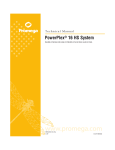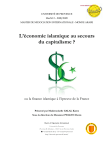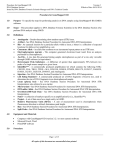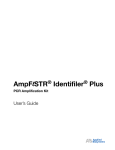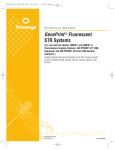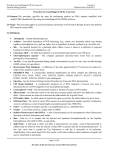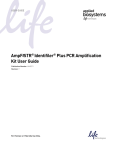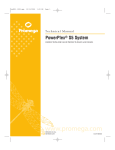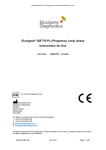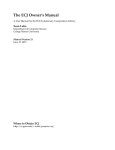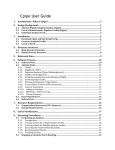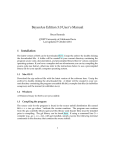Download ORIGINAL ARTICLE - DNA Reference Lab
Transcript
TRF 2899 1 2 ORIGINAL ARTICLE 3 4 5 A simple method for establishing concordance between short-tandem-repeat allele frequency databases _2899 1..8 6 7 Kevin Condel and M. Al. Salih 8 9 10 11 12 13 14 15 16 17 18 19 20 21 22 23 24 25 26 27 28 29 30 31 32 33 34 35 36 37 38 39 40 41 42 43 44 45 46 BACKGROUND: Current paternity and forensic accreditation standards do not require concordance to be established between short-tandem-repeat allele frequency databases representing the same population. The current statistical methods for evaluating databases do not establish concordance. Although acceptable under current forensic statistical methods, databases representing the same population may have sufficient variation to influence the outcome of a nondirect relationship testing result (i.e., siblingship). Hence there is a need for a quantitative method to determine concordance between databases. STUDY DESIGN AND METHODS: Local allele frequency databases were generated for major US ethnic groups. Statistical analysis was performed as recommended by international forensic standards. A new method was developed and used for evaluating concordance between the locally developed and published databases. Smaller deviation values signify greater concordance between compared databases. The results were quantitatively confirmed against data obtained from a multidimensional scaling analysis system (SPSS, SPSS, Inc.). RESULTS: The locally developed database deviated from the mean of the published data by approximately 0.1073 for Caucasians, 0.1341 for US Hispanics, and 0.1287 for African Americans. Upon pairwise comparison, the published databases deviated from one another by 0.1210 in US Caucasians, 0.1457 in US Hispanics, and 0.1228 in African Americans. The local database was observed to be more concordant to published databases than some of the published data to themselves. CONCLUSION: The developed database was shown to be concordant with four previously published databases using the new method. The results were confirmed by comparison to qualitative data obtained from the multidimensional scaling analysis system. A ccredited laboratories performing forensic DNA testing and/or relationship testing within the United States of America are required or strongly recommended by their respective accrediting bodies to perform internal validation studies on their allele frequency databases.1-3 This is evident in DNA Advisory Board Standard 8.1.2 and AABB Standard 5.5.2.1,3 However, these recommendations and requirements provide no information on the need to establish concordance between databases. No US regulatory agency has recognized a single allele frequency database as a standard by which to draw concordance (i.e., such as in the use of National Institute of Standards and Technology [NIST] traceable standards). As a result, multiple independently published databases exist that are sampled from the same general population(s). The acceptability of the allele frequencies in these databases is currently determined through statistical analysis of small samplings of individuals that are wholly unique to each individual database. These databases could contain individuals sampled from different geographical locations within the United States that fit the same general ethnic description, but are also uniquely admixed, belonging to subpopulations. A 47 48 49 50 51 52 53 54 55 56 57 58 59 60 61 62 63 64 65 66 67 68 69 70 71 ABBREVIATIONS: ALSCAL = alternating least squares calculation; CWI = combined deviation index; DRL = DNA Reference Laboratory; NIST = National Institute of Standards and Technology; STR(s) = short tandem repeat. 72 73 74 From the DNA Reference Laboratory, San Antonio, Texas. Address correspondence to: M. Al. Salih, DNA Reference Laboratory, 7271 Wurzbach Road, Suite 125, San Antonio, TX 78240; e-mail: [email protected]. This work was supported by the DNA Reference Laboratory’s own resources. The information submitted in this manuscript was presented at the Association of Forensic Directors and Administrators (AFDAA) Meeting in Austin, TX, on January 30, 2009. Received for publication May 21, 2010; revision received July 8, 2010, and accepted August 10, 2010. doi: 10.1111/j.1537-2995.2010.02899.x TRANSFUSION **;**:**-**. 77 78 79 80 81 82 83 84 85 86 87 88 89 Volume **, ** ** TRANSFUSION 1 75 76 TRF 2899 CONDEL AND SALIH 1 2 3 4 5 6 7 8 9 10 11 12 13 14 15 16 17 18 19 20 21 22 23 24 25 26 27 28 29 30 31 32 33 34 35 36 37 38 39 40 41 42 43 44 45 46 47 48 49 50 51 52 53 54 55 population database for a general ethnic population will likely vary from other similar databases if it contains a significant number of individuals belonging to a subpopulation. We have observed differences in allele frequencies of 10% or greater in two databases representing the same general ethnicity.4 For example, databases have been published on Virginia and Trinidad subpopulations of African Americans that when compared contain an allele frequency difference of 0.0964 at Allele 17 of the vWA locus.4 A 0.0876 difference at Allele 14 of Locus D8S1179, a 0.0984 difference at Allele 17 of Locus D18S51, differences of 0.0901 at Allele 10 and 0.0933 at Allele 13 of Locus D5S818, and a 0.1036 difference at Allele 7 of Locus TH01 were also observed between these two subpopulations.4 These allele frequency differences range from 8% to greater than 10% between databases representing the same major ethnic population. The pooling of this particular data was reported by the authors to be acceptable for forensic purposes.4 It has also been suggested that subpopulation groups within a major population group are genetically similar.2,4,5 While the practice of pooling similar databases provides for a much easier categorization, and is possible based on FST estimates, it also provides for lower match probabilities than those derived from the specific appropriate subpopulation groups.4,6 For relationship testing purposes, this type of pooling may not be appropriate for evaluating data for nondirect relationship testing (i.e., siblingship studies). Forensic identity statistics and direct paternity comparisons utilize statistics to provide weight to a predefined inclusion that is based on a specific set of physical allele matches between compared profiles.2 With nondirect relationship testing (siblingship, cousinship, etc.), statistics are used to define the result of related or unrelated as based on the measure of the index.7-12 Therefore, the measure of likelihood ratio will not affect the final overall result of inclusion or exclusion in a forensic identity or direct paternity comparison, but the measure of likelihood ratio can potentially affect the accuracy of a nondirect relationship test call. This is especially evident when testing two true half siblings.7-12 The use of general ethnic databases that are not concordant due to increased levels of individuals from subpopulations can compound these difficulties. A simple quantitative method was developed to provide a mean for determining if the independent databases available for the same general ethnic populations are concordant, that is, similar to each other within a measurable margin. The method was applied to measure concordance between a locally developed database and several previously published and widely utilized databases using individuals from the same general population. The quantitative results were compared to qualitative measurements obtained from a multidimensional scaling analysis system.13 This new proposed method is likely to provide some way to ensure that allele frequencies used 2 TRANSFUSION Volume **, ** ** among laboratories are relatively homogeneous regardless of the database used and also provide a simple way to detect if the general population database used is deviant from the mean and possibly containing subpopulation data. 56 57 58 59 60 61 MATERIALS AND METHODS 62 Proposed method variables 63 To establish concordance of a questioned population database to an established and published population database or databases, the proposed method requires that all databases compared conform to the following specific variables. 64 1. 69 70 2. 3. 4. 5. The database must contain allele frequency data for short tandem repeats (STRs) using loci common to the databases chosen for comparison. The chosen databases must have been sampled from the same geographic population (i.e., the United States). The chosen databases must represent populations of the same general ethnic origin (i.e., three different databases utilizing the US Hispanic population). All allele frequency databases compared to the database in question must have been validated and published in reputable scientific journals or otherwise deemed acceptable by the paternity or forensic community for use in casework analysis. At least two published databases sampled from the same population, ethnicities, and loci are required for comparison to a questioned database, but we recommend that as many databases as are available should be utilized for comparison to minimize the probability that the selected published databases are themselves discordant. 65 66 67 68 71 72 73 74 75 76 77 78 79 80 81 82 83 84 85 86 87 88 89 90 Theory of method 91 A deviation value “W” must be calculated between the two selected databases creating a numerical value representative of the difference between the databases at each locus. The method for calculating “W” is briefly described as follows: 92 93 94 95 96 1. Two databases are selected based on the proposed method variables previously stated. A single locus is selected common to both databases. For every allele at that locus the absolute value of the difference between the allele frequencies in both databases is recorded. The sum of the absolute values for all alleles equals the “W” for that particular locus. 97 98 99 100 101 102 103 104 The “W” values obtained for each locus are averaged to provide a combined deviation index (CWI) for the two 105 106 2. 3. 4. TRF 2899 METHOD OF CONCORDANCE FOR STR DATABASES 1 2 3 4 5 6 7 8 9 10 11 12 13 14 15 16 17 18 19 20 21 22 23 24 25 26 27 28 29 30 31 32 33 databases compared, which should not produce a significant diluting effect in comparison to the addition of the values. As the CWI approaches 0, the two compared databases become more concordant. Comparing two identical allele frequency databases will result in a CWI of 0. Threshold values for determining concordance are dependent on the databases chosen. It cannot be known whether a published database selected for comparison is itself concordant with the actual allele frequencies of the population. Therefore, at least two published databases meeting the proposed method variables must be selected, and the mean value of the allele frequencies between those databases must be obtained. If the absolute value of the difference between the CWI of the questioned database and the mean of the allele frequencies of the two published databases (represented here as “A”) exceeds 5% of the absolute value of the difference observed between the CWI of the two published databases (represented here as “B,” the cutoff point), then the questioned database is not concordant to the published databases. The 5% is representative of the upper bound of the 95% confidence interval (CI). The cutoff value in this case is relative, directly dependent on the published databases being utilized. As an example, a database is developed and its concordance to other databases is questioned. Let this questioned database equal Q. Two published databases exist, P1 and P2, to which the questioned database is compared. A CWI is calculated and equals the combined “W” index across all compared loci. To establish concordance, the following equation must be true: A ≤ B, where A = CWI (Q vs. ((P1 + P2) 2)) 34 B = CWI (P1 vs. P2) . 35 36 37 38 39 40 41 42 43 44 If the questioned database is checked for concordance against greater than two published databases, substitute into the equation for “B” the individual pairwise comparisons of the CWIs of P1, P2, P3 . . . Pn and perform the equation as many times as necessary to check for complete concordance across all published databases. This will result in values B1, B2, B3, . . . Bn representative of the total number of pairwise comparisons required to satisfy every combination available in databases P1 through Pn. Then A will equal 45 46 47 48 CWI (Q vs. ((P1 + P2 + . . . + Pn ) n )) and B will equal the cutoff value of 49 CWI (B1 + B2 + B3 + . . . + Bn n ) . 50 51 52 53 Generally, A ⱕ B must be satisfied order to establish concordance to the mean of the databases, but if applying the CI previously stated, the databases can be considered concordant until A exceeds B by greater than 5%. Development of a local allele frequency database 54 A DNA Reference Laboratory database (known further as DRL) was constructed for use in this study. Samples for DNA extraction were obtained as buccal swabs from unrelated adult individuals of US Hispanic, US Caucasian, and African American ethnicity collected for the purposes of relationship testing in accordance with the AABB seventh edition Standards for Relationship Testing Laboratories.3 To obtain a large database size, 510 US Caucasians, 300 African Americans, and 509 US Hispanics were amplified and detected using computer software (PowerPlex 16, Promega Corp., Madison, WI). Statistical chi-square and Fisher’s exact tests, linkage disequilibrium, FST estimates, expected heterozygosities (HE), and observed (HO) heterozygosities were calculated using the software provided by P. Lewis (Genetic Data Analysis, Department of Ecology and Evolutionary Biology, The University of Connecticut, Storrs, CT).14,15 The linkage disequilibrium values were calculated for all possible pairs of available loci assuming Hardy-Weinberg equilibrium.14,15 Allele frequencies were calculated using computer software (PowerStats v.12, Promega Corp.).16 Due to the larger sample sizes analyzed in this study compared to previously published data, an increased number of rare alleles and microvariants were observed in the database, as was expected (data not shown).2,4,17-19 There was minimal evidence of departure from Hardy-Weinberg expectations in any population studied (data not shown). The FST estimate over all 15 STR loci was 0.009 for Hispanics, 0.006 for Caucasians, and 0.005 for African Americans (data not shown). These values are all lower than the conservative recommended threshold value of 0.01, and comparison to previous published values shows no significant differences.1,4,17 No significant departures were observed among linkage disequilibrium values calculated for pairwise comparisons of all loci analyzed (data not shown). The complete DRL database and data set are available upon request via e-mail at [email protected]. 55 56 57 58 59 60 61 62 63 64 65 66 67 68 69 70 71 72 73 74 75 76 77 78 79 80 81 82 83 84 85 86 87 88 89 90 91 92 Application of the database to the method The DRL databases generated for this study met the previously stated method variables required to perform concordance comparisons. The DRL population data was compared to African American, US Caucasian, and US Hispanic population data from four independently published sources also meeting the required method variables as previously stated.2,17-19 Each published source contains databases of African American, US Caucasian, and US Hispanic data from the United States. The first set, referenced here as the “NIST” database, was reprinted in Forensic DNA Typing.2 The second set, referenced here as the “FBI” database, was developed by Budowle and coworkers in 1999.17 The third set, mentioned here as the “Promega” database, is a national US database distributed Volume **, ** ** TRANSFUSION 3 93 94 95 96 97 98 99 100 101 102 103 104 105 106 107 TRF 2899 CONDEL AND SALIH 1 2 3 4 5 6 7 8 9 10 by Promega Corp. via its own publications and Web sites.18 The fourth set is a national US database distributed by Applied Biosystems via its own publications and Web sites referenced here as the “ABI” database.19 Only the CODIS loci were selected and applied to the method, because these loci are the only ones common to all the selected databases. The proposed concordance method was applied to this data in the following manner: 1. 11 12 13 14 15 2. 16 17 18 19 20 21 22 23 24 25 3. DRL data “Q” was separately compared to NIST data “P1,” FBI data “P2,” ABI data “P3,” and Promega data “P4” to calculate “A.” Only databases sampling from the same ethnicity were compared. The value for “A” was calculated with A = |CWI (Q vs. ((P1 + P2 + P3 + P4)/4))|. NIST data “P1,” FBI data “P2,” ABI data “P3,” and Promega data “P4” were compared pairwise to calculate “B.” The combined value for “B” was calculated using the equation B = ((|CWI (P1 vs. P2)| + |CWI (P1 vs. P3)| + |CWI (P1 vs. P4)| + |CWI (P2 vs. P3)| + |CWI (P2 vs. P4)| + |CWI (P3 vs. P4)|)/6). “A” was compared to “B.” If A < B, then Q was concordant. If A > B, and “A” differed from “B” by less than 5%, then Q was concordant. If A < B and “A” differed from “B” more than 5%, then Q was not concordant according to this method. 26 27 28 29 30 31 32 33 34 35 36 37 38 39 40 41 42 43 44 Confirmation of the method using multidimensional scaling analysis mately 0.1073 for Caucasians, 0.1341 for US Hispanics, and 0.1287 for African Americans as indicated in Table 1. When compared to each other, Table 1 reveals that the published data sets P1 to P4 possess combined overall deviation values “B” of 0.1210 for US Caucasians, 0.1457 for US Hispanics, and 0.1228 for African Americans. The Caucasian and Hispanic deviation values “B” are, respectively, higher than the deviation values “A” obtained when comparing the mean of the two databases to DRL data, so A ⱕ B for databases representing those ethnicities where concordance is established. As indicated in Table 1, “A” is slightly greater than “B” for African Americans. This slight variation may be due to a small inclusion of several samples from the African continent, representing a subpopulation of African Americans. A calculation of 5% of the mean CWI between pairwise comparisons B1 to B6 (i.e., 5% of “B”) equals 0.0061, and “A” differs from “B” by just 0.0059 for African Americans. In this instance, “A” is greater than “B” by a value less than 5% of B, so Q is concordant to the published African American databases compared under the proposed method. To confirm the results of the proposed method, the allele frequency data from each database utilized was input into SPSS and a plot was generated with ALSCAL performing a multidimensional scaling analysis of the data. Fig. 1 is a qualitative representation of the ALSCAL analysis calculated between the allele frequencies reported for each database at each ethnicity using values on the X, Y, and Z axes in Euclidean distance units further defined in the software.13 Databases are each represented as points in three-dimensional space. Databases are considered to be more similar as two points representing those databases become closer in the figure. Databases represented by two separate points that share the same physical space contain identical data. In Fig. 1, the points representing different databases with common ethnicities are generally grouped closer together than points representing databases of different ethnicities. The data in Fig. 1 indicate that the DRL data are clustered near the published data groups for all ethnicities. This qualitative result supports those obtained from the quantitative CWI data of the proposed method. Further investigation was needed to confirm that any result obtained from the proposed method was truly representative of the concordance between the databases. The frequency data was entered into computer software (Statistical Package for Social Sciences [SPSS], Version 14.0, SPSS, Inc., Chicago IL) and a plot was generated with alternating least squares calculation (ALSCAL) to perform a multidimensional scaling analysis of the data.13 ALSCAL uses an alternating least squares algorithm to perform multidimensional scaling and multidimensional unfolding.13 The Euclidean distance model was selected, is the default model within the ALSCAL analysis, and can be used with any type of proximity matrix.13 The remainder of TABLE 1. CWI values for database comparisons* the options for ALSCAL in SPSS were set Database (by ethnicity) to default. Value Details Hispanic Caucasian African American 45 46 RESULTS 47 48 49 50 51 52 Upon calculation of the CWI values using the newly proposed method, it was discovered that the DRL data, or Q, were found to deviate from the mean of the published data sets with a combined overall deviation value “A” of approxi4 TRANSFUSION Volume **, ** ** B1 B2 B3 B4 B5 B6 B A CWI of NIST vs. FBI CWI of NIST vs. ABI CWI of NIST vs. Promega CWI of FBI vs. ABI CWI of FBI v. Promega CWI of ABI vs. Promega Mean CWI of B1-B6 CWI of DRL vs. ((P1 + P2 + P3 + P4)/4) 0.2009 0.1565 0.1705 0.0874 0.1470 0.1118 0.1457 0.1341 0.1292 0.1242 0.1482 0.0786 0.1181 0.1276 0.1210 0.1073 * Between pairwise comparisons of allele frequency databases. 0.1261 0.1143 0.1419 0.0811 0.1478 0.1260 0.1228 0.1287 53 54 55 56 57 58 59 60 61 62 63 64 65 66 67 68 69 70 71 72 73 74 75 76 77 78 79 80 81 82 83 84 85 86 87 88 89 90 91 92 93 94 95 96 97 98 99 100 101 102 103 104 105 106 107 108 TRF 2899 METHOD OF CONCORDANCE FOR STR DATABASES 1 DISCUSSION 2 3 It is accepted that the magnitude of a likelihood ratio is irrevocably tied to the frequency of alleles that are shared among the parties tested.7 This becomes more or less evident depending on the allelic donation pattern observed between tested parties. A change in likelihood ratio can affect the result of a nondirect relationship test, 4 5 6 7 8 Fig. 1. ALSCAL multidimensional analysis of data using SPSS. NIST = NIST database;2 Prom = Promega database;18 FBI = FBI database;17 ABI = Applied Biosystems database;19 DRL = DNA Reference Laboratory database; AF = African American; Hisp = Hispanic; Cauc = Caucasian. 9 10 11 12 13 especially in loci where both parties possess homozygous matching alleles. The formula for calculating the halfsibling index at a locus where both alleged siblings share homozygous alleles is (2k1a + k0a)/a, where “a” is the allele frequency, k1 is a constant 0.25, and k0 is a constant 0.5.8 The formula used for calculating the full sibling index when both parties possess homozygous matching alleles is (k2 + 2k1a + k0(a2))/(a2), where “a” is the allele frequency and k2, k1, and k0 are all constants equaling 0.25.8 The half-sibling index will equal exactly 1 in this situation at all times regardless of the allele frequency, while the full sibling index will sharply increase or decrease dependent on the rarity of the allele. To demonstrate, a nonprobative siblingship study was performed where the African American full siblings both possessed a homozygous 7 at TH01. This test is shown in Table 2. The full sibling index measured 94.04, and the half-sibling index was 72.97. The 7 allele at TH01 was previously observed to have allele frequency differences of 0.1036 between two population databases both classified as African American.4 A second siblingship test was performed as shown in Table 3, with a modification to the allele frequency of the shared TH01 Allele 7. By increasing the frequency of the shared 7 allele from 0.376 to 0.476, approximately 0.1, the full sibling index dropped to 67.51, while the half-sibling index remained at 72.97. The full sibling to half-sibling ratio changed from 1.29 to 0.93, changing the final result from a possible full sibling to favoring half-sibling. One simple 10% change in an allele frequency at a critical locus can change the result of a siblingship test. Therefore, the reliability of the allele frequency database is an absolute necessity when regarding relationship testing. This can be accomplished through the measure of concordance between allele frequency databases. 14 TABLE 2. Siblingship test performed with normal TH01 frequency* 15 16 17 18 19 20 21 22 23 24 25 26 27 28 29 30 31 32 33 Locus D3S1358 THO1† D21S11 D18S51 Penta E D5S818 D13S317 D7S820 D16S539 CSF1PO Penta D vWA D8S1179 TPOX FGA 34 35 36 37 * Formulas used to calculate half-sibling and full sibling index are reported elsewhere.8 Promega database was used to obtain allele frequencies (actual alleles represented as A-D).18 † ••. HSI = half-sibling index; FSI = full sibling index. 5 Profile Sibling A A† A,B A,B A,B A,B A A A,B A A,B A,B A,B A,B A,B 1 Profile Sibling A,B A† B,C C B,C A,B B,C A,B B,C A B,C B,C B,C B B,C 2 Frequency of A 0.316 0.376† 0.046 0.071 0.135 0.342 0.309 0.235 0.316 0.261 0.129 0.207 0.337 0.21 0.012 Combined indexes Frequency of B 0.258 HSI 1.291 1.000† 3.217 0.500 1.426 1.350 0.500 1.564 0.896 1.000 1.469 1.104 0.871 1.690 10.917 72.970 FSI 1.041 3.348† 2.967 0.250 1.176 2.517 0.250 1.314 0.646 5.836 1.219 0.854 0.621 1.440 10.667 94.037 Volume **, ** ** TRANSFUSION 5 38 39 40 41 42 43 44 45 46 47 48 49 50 51 52 53 54 55 56 57 58 59 60 61 62 63 64 65 66 67 68 69 70 71 TRF 2899 CONDEL AND SALIH TABLE 3. Siblingship test performed with elevated TH01 frequency* 1 2 3 4 5 6 7 8 9 10 11 12 13 14 15 16 17 18 19 Locus D3S1358 THO1† D21S11 D18S51 Penta E D5S818 D13S317 D7S820 D16S539 CSF1PO Penta D vWA D8S1179 TPOX FGA 20 21 22 23 * Formulas used to calculate half-sibling and full sibling index are reported elsewhere.8 Promega database was used to obtain allele frequencies (actual alleles represented as A-D).18 † ••. HSI = half sibling index; FSI = full sibling index. Profile Sibling 1 A A† A,B A,B A,B A,B A A A,B A A,B A,B A,B A,B A,B Profile Sibling 2 A,B A† B,C C B,C A,B B,C A,B B,C A B,C B,C B,C B B,C Frequency of A 0.316 0.476† 0.046 0.071 0.135 0.342 0.309 0.235 0.316 0.261 0.129 0.207 0.337 0.21 0.012 Combined indexes Frequency of B 0.258 HSI 1.291 1.000† 3.217 0.500 1.426 1.350 0.500 1.564 0.896 1.000 1.469 1.104 0.871 1.690 10.917 72.970 FSI 1.041 2.404† 2.967 0.250 1.176 2.517 0.250 1.314 0.646 5.836 1.219 0.854 0.621 1.440 10.667 67.514 24 25 26 27 28 29 30 31 32 33 34 35 36 37 38 39 40 41 42 43 44 45 46 47 48 49 50 51 52 53 54 55 56 57 58 A method has been proposed that offers an effective means for establishing concordance between multiple allele frequency databases sampled from the same general population. The results of this method are in a quantitative format, providing a single numerical indicator that identifies databases as ideally concordant when approaching zero and assigns discordance when a database exceeds 5% of the mean of each published database comparison. The method and concept are effective for ensuring that a database used to calculate relationship testing statistics is not one that is significantly influenced by individuals from subpopulations. This proposed method provides this assurance via a means for comparison to multiple similar published databases. The method proposed does not pool data sets, as have others, but rather assesses and compares independent databases.4-6 The method does not require the DNA profiles of every sample in the database to be available, only the allele frequencies that are readily published, making concordance estimates possible in cases where the original DNA profiles are not available. A possibility exists that published databases could be compared to one another using this method to analyze potential deviations, but the fact remains that these databases are accepted for use under current standards.1-3 The objective of this article is not to establish a method to invalidate currently accepted databases, but instead to establish a method that will provide a simple and straightforward means for establishing concordance between new databases and those databases currently accepted. The proposed method will allow those laboratories with internally generated databases to compare their data to other published databases to identify possible discordance due to subpopulation data inclusion and so forth that could affect the validity of relationship testing results. 6 TRANSFUSION Volume **, ** ** Formal statistical methods (e.g., FST correction, HardyWeinberg equilibrium, linkage disequilibrium) that have been accepted by the forensic community as effective for validating databases and the allele frequencies they generate are not considered invalid with the incorporation of this method.1-3,14 Still, there is some debate on the usefulness of certain popularized statistics (e.g., Hardy-Weinberg equilibrium), offering more evidence as to why an alternate method for establishing the statistical value of databases is needed.6,20 It would be feasible to include SPSS as a viable alternative rather than simply a confirmation to the proposed method, but the ALSCAL alternative provides no criteria for determining the cutoff value or maximum genetic distance after which two databases can be considered discordant.13 In addition, the use of the SPSS program has not been popularized within the US paternity or forensic communities and the result format is largely qualitative. The DRL database was determined to be acceptable through currently accepted formal statistical methods, and comparing the DRL databases to published sources using this proposed method provided a strong quantitative indication that this locally developed allele frequency database is in concordance with the mean of the database comparisons represented by the same loci, ethnicities, and general populations.2,17-19 59 60 61 62 63 64 65 66 67 68 69 70 71 72 73 74 75 76 77 78 79 80 81 82 83 84 ACKNOWLEDGMENTS 85 The authors are grateful to Dr Dennis Reeder and Dr Joseph Warren for their technical review and contributions to this manuscript. The authors also thank Amira K. Cortez, MS, for her assistance in the presentation of this information at the Association of Forensic Directors and Administrators (AFDAA) Meeting in Austin, TX, on January 30, 2009. 86 87 88 89 90 91 TRF 2899 METHOD OF CONCORDANCE FOR STR DATABASES CONFLICT OF INTEREST 1 2 The authors have no conflict of interest regarding this manuscript 3 or its contents. 4 REFERENCES 5 1. National Research Council II Report. The evaluation of 6 7 forensic DNA evidence. Washington, D.C.: National Academy Press, 1996, p. 87-8. 8 9 10 2. Butler, JM. Forensic DNA typing: biology, technology, and genetics of STR markers. 2nd ed. New York: Elsevier; 2005. 11 3. The American Association of Blood Banks. Standards for relationship testing laboratories. 8th ed. Bethesda (MD): ••; 2007. 4. Budowle B, Shea B, Niezgoda S, Chakraborty R. CODIS STR 12 1 13 14 15 16 17 18 1 loci data from 41 sample populations. J Forensic Sci 2001; 46(3):453-89. 5. Budowle B, Masibay A, Anderson S, Barna C, Biega L, Brenneke S, Brown BL, Cramer J, DeGroot GA, Douglas D, 19 Duceman B, Eastman A, Giles R, Hamill J, Haase DJ, 20 21 22 Janssen DW, Kupferschmid TD, Lawton T, Lemire C, Llewellyn B, Moretti T, Neves J, Palaski C, Schueler S, Yet D, et al. STR primer concordance study. Forensic Sci Int 2001; 23 24 25 26 27 124: 47-54. 6. Gill P, Foreman L, Buckleton JS, Triggs CM, Allen H. A comparison of adjustment methods to test the robustness of an STR DNA database comprised of 24 European popu- 28 29 lations. Forensic Sci Int 2003;131:184-96. 7. Allen R, Fu J, Reid T, Baird M. Considerations for the interpretation of STR results in cases of questioned half-sibship. 30 31 32 33 34 35 Transfusion 2007;47:515-9. 8. Wenk RE, Traver M, Chiafari FA. Determination of sibship in any two persons. Transfusion 1996;36:259-62. 9. Wenk RE, Chiafari FA. Distinguishing full siblings from half-siblings in limited pedigrees. Transfusion 2000;40: 44-7. 10. Gaytmenn R, Hildebrand DP, Sweet D, Pretty IA. Determi- 36 nation of the sensitivity and specificity of sibship calcula- 37 tions using AmpFlSTR Profiler Plus. Int J Legal Med 2002; 116:161-4. 38 39 11. Thomson JA, Ayres KL, Pilotti V, Barrett MN, Walker JIH, 40 Debenham PG. Analysis of disputed single-parent/child 41 42 and sibling relationships using 16 STR loci. Int J Legal Med 2001;115:128-34. 43 12. Gorlin JB, Polesky HF. The use and abuse of the full-sibling 44 and half sibling indices. Transfusion 2000;40:1148-9. 13. SPSS [computer program]. Version 14.0. Chicago (IL). 2005 45 46 [cited •• •• ••].Available from: URL: http://www.spss.com 22 14. Guo, SW, Thompson EA. Performing the Exact tests of Hardy-Weinberg proportion for multiple alleles. Biometrics 47 48 49 1992;48:361-72. 50 15. Lewis, PO, Zaykin D. Genetic data analysis: computer 51 program for the analysis of allelic data. Version 1.0. [cited •• •• ••].2001 Available from: URL: http:// 52 53 lewis.eeb.uconn.edu/lewishome/software.html. 54 16. Promega Corporation. PowerStats [computer program]. Version 12. 2002. 17. Budowle B, Moretti TR, Baumstark AL, Defenbaugh DA, 55 56 57 Keys KM. Population Data on the Thirteen CODIS Core Short Tandem Repeat Loci in African Americans, U.S. Caucasians, Hispanics, Bahamians, Jamaicans, and Trinidadi- 58 59 60 61 ans. J Forensic Sci 1999;44(6):1277-86. 18. Promega Corporation. Population Data. Allele Frequencies. •• [cited •• •• ••]. Available from: URL: http://www. promega.com/techserv/apps/hmnid/ referenceinformation/popstat/custstat_Allelefreq.htm 19. Applied Biosystems. AmpFlSTR® Identifiler® PCR Amplification Kit User’s Manual; part# 4323291. •• [cited •• •• ••]. Available from: URL: http://www.appliedbiosystems.com/ 20. Evett IW, Buckleton JS. Statistical Analysis of STR data. In Carracedo A, Brinkmann B, and Bar W, editors. Advances in forensic haemgenetics. New York: Springer-Verlag 1996. p. 79-86. Volume **, ** ** TRANSFUSION 7 62 63 64 33 44 65 66 67 68 69 70 71 72 Journal Code: TRF Article No: 2899 Page Extent: 7 Toppan Best-set Premedia Limited Proofreader: Emily Delivery date: 7 September 2010 AUTHOR QUERY FORM Dear Author, During the preparation of your manuscript for publication, the questions listed below have arisen. Please attend to these matters and return this form with your proof. Many thanks for your assistance. Query References Query q1 AUTHOR: Please supply the name of the publisher for Reference 3. q2 AUTHOR: Please check all the website addresses throughout the article and confirm that they are correct. (Please note that it is the responsibility of the author(s) to ensure that all URLs given in this article are correct and useable.) And Please supply the accessed date for References 13, 15, 18, 19. q3 AUTHOR: Please supply the year of the publication for Reference 18. q4 AUTHOR: Please supply the year of publication for Reference 19. q5 AUTHOR: please denote significance of bold text in original manuscript in dagger footnote to Tables 2 and 3. Remark USING E-ANNOTATION TOOLS FOR ELECTRONIC PROOF CORRECTION Required Software Adobe Acrobat Professional or Acrobat Reader (version 7.0 or above) is required to e-annotate PDFs. Acrobat 8 Reader is a free download: http://www.adobe.com/products/acrobat/readstep2.html Once you have Acrobat Reader 8 on your PC and open the proof, you will see the Commenting Toolbar (if it does not appear automatically go to Tools>Commenting>Commenting Toolbar). The Commenting Toolbar looks like this: If you experience problems annotating files in Adobe Acrobat Reader 9 then you may need to change a preference setting in order to edit. In the “Documents” category under “Edit – Preferences”, please select the category ‘Documents’ and change the setting “PDF/A mode:” to “Never”. Note Tool — For making notes at specific points in the text Marks a point on the paper where a note or question needs to be addressed. How to use it: 1. Right click into area of either inserted text or relevance to note 2. Select Add Note and a yellow speech bubble symbol and text box will appear 3. Type comment into the text box 4. Click the X in the top right hand corner of the note box to close. Replacement text tool — For deleting one word/section of text and replacing it Strikes red line through text and opens up a replacement text box. How to use it: 1. Select cursor from toolbar 2. Highlight word or sentence 3. Right click 4. Select Replace Text (Comment) option 5. Type replacement text in blue box 6. Click outside of the blue box to close Cross out text tool — For deleting text when there is nothing to replace selection Strikes through text in a red line. How to use it: 1. Select cursor from toolbar 2. Highlight word or sentence 3. Right click 4. Select Cross Out Text Page 1 of 3 Approved tool — For approving a proof and that no corrections at all are required. How to use it: 1. Click on the Stamp Tool in the toolbar 2. Select the Approved rubber stamp from the ‘standard business’ selection 3. Click on the text where you want to rubber stamp to appear (usually first page) Highlight tool — For highlighting selection that should be changed to bold or italic. Highlights text in yellow and opens up a text box. How to use it: 1. Select Highlighter Tool from the commenting toolbar 2. Highlight the desired text 3. Add a note detailing the required change Attach File Tool — For inserting large amounts of text or replacement figures as a files. Inserts symbol and speech bubble where a file has been inserted. How to use it: 1. Click on paperclip icon in the commenting toolbar 2. Click where you want to insert the attachment 3. Select the saved file from your PC/network 4. Select appearance of icon (paperclip, graph, attachment or tag) and close Pencil tool — For circling parts of figures or making freeform marks Creates freeform shapes with a pencil tool. Particularly with graphics within the proof it may be useful to use the Drawing Markups toolbar. These tools allow you to draw circles, lines and comment on these marks. How to use it: 1. Select Tools > Drawing Markups > Pencil Tool 2. Draw with the cursor 3. Multiple pieces of pencil annotation can be grouped together 4. Once finished, move the cursor over the shape until an arrowhead appears and right click 5. Select Open Pop-Up Note and type in a details of required change 6. Click the X in the top right hand corner of the note box to close. Page 2 of 3 Help For further information on how to annotate proofs click on the Help button to activate a list of instructions: Page 3 of 3











